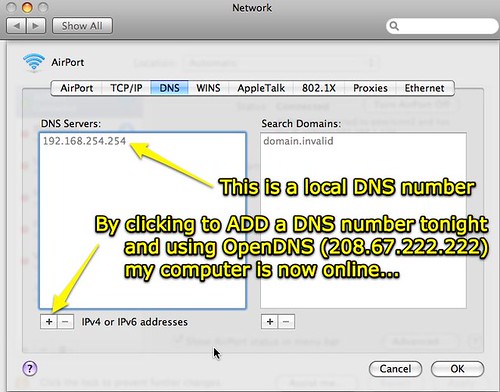I’m staying in Stilwell, Oklahoma, for a Celebrate Oklahoma Voices digital storytelling workshop this week, and my hotel provides free WiFi. I was able to connect to the wireless access point fine, but my web browsers wouldn’t resolve any URLs (websites) for some reason. I noticed that Skype seemed to show my status as online, however, so this seemed to suggest a DNS problem. Skype was working, but my web browsers were not.
DNS stands for “domain name system” and every Internet-connected computer needs to have the address of a functional and accessible DNS server saved in its network settings to properly display websites in a browser when words are used for the addresses instead of IP addresses. DNS servers convert domain names or host names into their IP address equivalents. I checked my Internet settings to troubleshoot this and noticed that the DNS address provided by the hotel wireless access point started with “192.” This is a local IP address. It should work, but in this case it wasn’t.
By adding a functional DNS address to this list and applying the change, my computer’s web browsers were miraculously made functional! I used the DNS settings from OpenDNS, which is a free service I use at home to provide basic content filtering. Those numbers are:
208.67.222.222 and 208.67.220.220
I’m not sure if other hotel guests have figured this out or just assumed the wireless Internet here isn’t working. This was a case where a little technical knowledge about DNS went a long way! 🙂
Thankfully I have an AT&T WiFi connection card that I was able to use to connect online (at an excruciatingly slow rate, since they just have EDGE connectivity here in Stilwell) and get the DNS numbers from the OpenDNS website. Saved again by the cell phone data card.
I have learned a great deal about DNS and other networking issues in the past few years listening to different episodes of the Security Now! Podcast with Steve Gibson and Leo Laporte. I recommend listening to Episodes #25 and #26, “How the Internet Works” Parts 1 and 2, for an excellent overview of DNS along with other connectivity and networking basics.
Technorati Tags:
dns, hotel, wireless, wifi, troubleshoot, computer, laptop



Comments
2 responses to “An evening when DNS knowledge came in handy”
I know that some people really like OpenDNS (which to me is anything but “open”), and that may work fine for you, but if you ever get stuck without any way to look up a good DNS server IP address, you can use 4.2.2.2, which is a rather memorable address that is provided for free. It seems to have worked well for me in the past when I’ve needed one.
Agree with the above comment. Also, it’s no problem to leave “backup” DNS addresses in your list for situations like this. You can just rearrange the order of the DNS servers as needed if you have trouble.